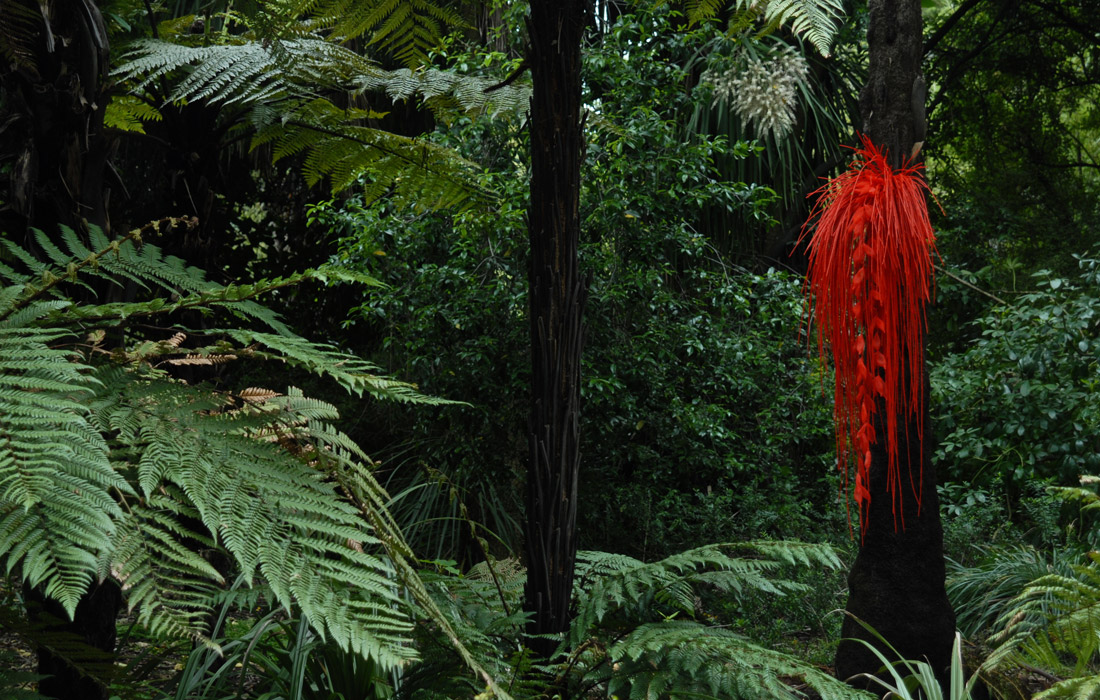Supernatural
Emma Davies recent sculptures in polypropylene are currently on show (in a joint exhibition with Alick Tipoti’s linocuts).
This is her first exhibition at a major commercial gallery and Davies’ work is increasingly better known. Her engagement with the difficult polypropylene medium has caught the eye of curators and collectors in recently years, and the exhibition underscore the importance of the contemporary gallerist in bringing new art forward to the public – Caston has an acutely good eye. Two major lines of work are on show. There are intensely vibrant, botanically-inspired plant forms and a darker stream of small format figurative sculptures.
Davies initial attraction to polypropylene stems from an interest in woven forms. Using plastic mesh – the type we are familiar with onion bags and commercial packaging- she produced a series of simple molded baskets. If you tackle the web with forensic intensity you should also be able to find images of what seem to be her earliest work, simply molded decorative bowl pieces and representation renderings of birds on fuzzy plastic wound branches.
These early struggles with the medium are both simple and uncertain in their execution- first attempts at using an arduously difficult medium. Polypropylene needs to be heated to finger-burning intensity to be fusible and workable but at these temperatures it can also simply melt away, drip or burn. The best of this early work was exhibited in the Woven Forms, Cross Poly-nate exhibition organized by Craft Victoria.
The works on show at Caston are superb and display a transcend mastery of this self-selected medium. Other artists have worked in polyproplylene – a few years ago you could have seen kilograms of the stuff extruded, on a timer, in hot red taffy mounds at the SanFransico Museum of Modern Art Machine art exhibition, but few have ever mastered it as sculpting medium. There is no reference to the largely industrial and massively manufactured nature of the polymer. The hints Davies would do this were already evident in the meticulously fused filigrees displayed in her vessel form Orange Flower, (30X20cm, 2005) exhibited at Christine Ahrahams.
Here organic forms in the current exhibition include striking tropical Palm flower inspired works such as Hybrid (147X 74X 45 cm) astonishing wrought from vibrant orange netting. This works bursts with draping tendrils of rolled and comnpress mesh set over delicatately crafted seedpods.
Climbing vine, (notionally 450X 355 cm) combining the palm flower form with dendriform branches and tapers of Illawara flame tree shaped pods. The Flame tree pods, each sensoulsy curved and meticulaous formed find their most arresting expression in Flaming Tree Collar (87×66.15cm) a rough of orange pods atop a broom of spiking black tapers- this work recall the crafting of organza flowers in Parisian Haute Couture. In the same space here immensely delicate whisps of long traipsing Boas belies the robustness of the polymer medium – they are so light that the move as you walk past.
The best works, however, are a set of seven small format figurative pieces – anthropomorphized monkeys and birds. These were inspired by encounters with bush medicine relics in Soweto market – dried animals and carcasses – during Davies’ cultural work in South Africa with the South Project. The seven pieces number seven young actors who recounted harrowing stories of daily life. And the works do have a slightly funeral feel. Superficially they resemble Giacometti in the extreme attenuation of the limbs.
But where as Giacometti achieved a strangely scaleless monumentality in even his smallest works though a static, almost Cycladian simplisitic, Davies imbues her pieces with gestural animation-she understands the expressive potential of a subtle curve- that holds them exactly at the their tiny size. The most engrossing of the works are the primate forms ( Sipho, Modua and Tumi, all about 44 cm high) because the fingers to the artist have left an almost imperceptible mattness on the surface of polypropylene during molding that softness its otherwise stark reflective surface.
Theses are at once beautiful and emotional works.
Web resources:
Emma Davies has written a short essay, highly informative on her practice in polypropylene medium downloadable as a PDF at the DesigningFutures website. The video posting is unfortunately no longer live.
Collector notes:
Davies has been curated into both national and international exhibitions: Woven Forms, Cross Poly-nate at Craft Victoria, and Australian Vessels RA Gallery, Amsterdam ( a commercial Gallery). Media coverage includes the ABC The Arts Show 2006. Works exhibited at Christine Abrahams was part of group charity show for the Murdoch Children’s Research Institute.
Price for small works amd Boas $500-1500, larger botanicals $4500-7500
Conservation note:
Polypropylene, and the organic pigments used to colour this polymer, are both subject to light degradation especially light in the UV spectrum and oxidation. This can be mitigated to a large extent by additive (UV light absorbers and stabilizers) but the chemical composition of the polypropylenes used here is uncertain. As this remains a seldom used and seldom conserved art medium we were unable to source authorative conservation guidelines. Based on the chemistry of poly propylene and is colourant it would seem judicious to treat works in this medium according to the same light exclusion and temperature used for fine papers. The polymer melts at temperatures as low as 120ºC and can carry a substantial static electrical charge likely to affect surface particulate deposition over time.
Ciba Speciality Chemicals, a major manufacturer, is a good source for technical information on polypropylene.
Level 1, 12 River Street, South Yarra, Victoria
Open: Tuesday to Saturday 12-5pm telephone: 03 9804 7366
web: www.nelliecastangallery.com
by Gary Anderson
Arts Hub
Wednesday, February 06, 2008
Emma Davies
Supernatural
2-23 February, 2008
Nelllie Caston Gallery





